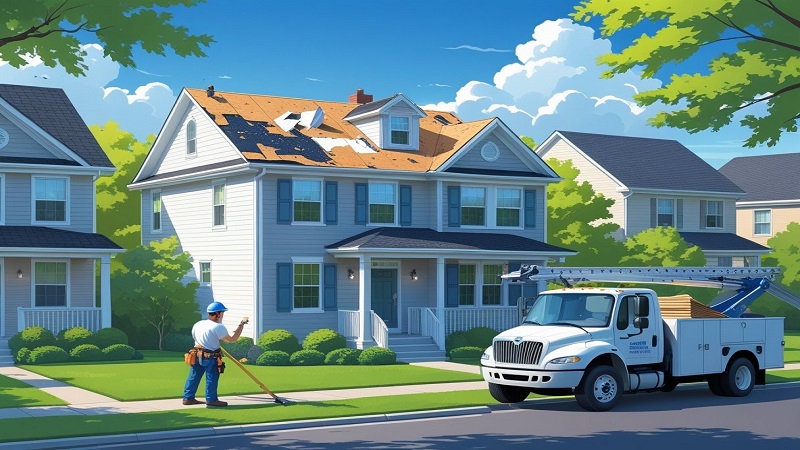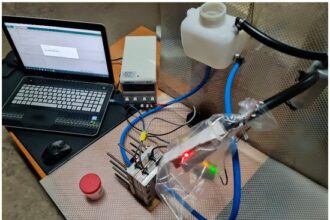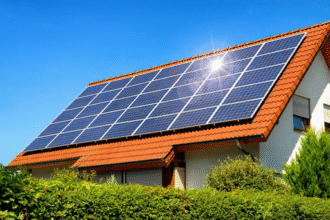Columbus homeowners face distinct roofing challenges due to Ohio’s humid continental climate, which brings heavy winter snowfall, ice storms, and intense summer heat. These weather extremes can gradually damage roofing materials, making it essential for property owners to recognize when repairs are no longer sufficient.
Most roofs need replacement when they show multiple warning signs such as widespread shingle damage, persistent leaks, or have reached 20-25 years of age. However, the decision involves more than just identifying problems, as factors like cost, timing, and material selection all play crucial roles in the replacement process.
Understanding the specific indicators that signal replacement time and knowing what to expect during the process can help homeowners make informed decisions about protecting their investment. The key lies in recognizing early warning signs and planning appropriately for this significant home improvement project.
Key Signs You Need a Roof Replacement in Columbus, Ohio
Columbus homeowners face unique roofing challenges due to Ohio’s harsh freeze-thaw cycles, which can accelerate wear and reduce typical roof lifespans. Recognizing critical warning signs like age-related deterioration, visible shingle damage, water infiltration, and structural issues helps prevent costly repairs and protects property value.
Age and Lifespan of Your Roof
Most roofs in Columbus last between 20 to 25 years under normal conditions. Ohio’s climate presents specific challenges that can shorten this timeframe significantly.
Freeze-thaw cycles cause materials to expand and contract repeatedly. This process weakens shingles, flashing, and underlayment over time.
Temperature fluctuations stress roofing materials year-round. Ice dams form during winter months, forcing water under shingles.
Different materials have varying lifespans:
- Asphalt shingles: 15-25 years
- Metal roofing: 40-70 years
- Clay tiles: 50-100 years
- Wood shingles: 20-40 years
Roofs approaching their expected lifespan require closer inspection. Even well-maintained roofs show deterioration after two decades of Columbus weather exposure.
Visible Damage: Missing or Damaged Shingles
Missing shingles create immediate vulnerability to water penetration. Wind damage often starts with loose or cracked shingles that eventually blow off completely.
Damaged shingles appear cracked, curled, or buckled. Granule loss exposes the underlying asphalt to UV damage and weather.
Key visual indicators include:
- Shingles with exposed nail heads
- Cracked or split shingle surfaces
- Curling edges or corners
- Bald spots where granules have worn away
Multiple damaged areas across the roof surface indicate widespread deterioration. Isolated damage may require spot repairs, but extensive shingle problems necessitate full roof replacement.
Storm damage accelerates these issues. High winds, hail, and falling debris compromise shingle integrity and protective barriers.
Water Stains, Leaks, and Interior Issues
Water stains on ceilings or walls indicate roof penetration. These brown or yellow marks often appear after heavy rainfall or snow melts.
Interior signs of roof failure:
- Damp spots in attic insulation
- Mold growth on ceiling surfaces
- Peeling paint near roof lines
- Musty odors in upper floors
Active leaks require immediate attention. Water damage spreads quickly through structural materials and insulation.
Stains may appear far from the actual leak source. Water travels along rafters and underlayment before dripping into living spaces.
Multiple leak points suggest comprehensive roof system failure. Single leaks might be repairable, but widespread water infiltration indicates the need to replace your roof entirely.
Sagging Roof and Structural Concerns
A sagging roof represents serious structural compromise that demands immediate professional evaluation. This condition poses safety risks to occupants and property.
Sagging occurs when roof decking, rafters, or trusses weaken from water damage or excessive load. Snow accumulation can worsen existing structural problems.
Warning signs of structural issues:
- Visible dips or curves in roof lines
- Doors or windows that stick or won’t close properly
- Cracks in exterior walls near the roof line
- Separation between roof and walls
Structural damage often requires complete roof replacement along with underlying framework repairs. Temporary supports may be necessary during replacement work.
Professional inspection determines the extent of structural compromise. Insurance coverage may apply to storm-related structural damage.
How to Decide and What to Expect When Replacing Your Roof
A professional roof inspection reveals the true condition of your roofing system and guides material selection decisions. Columbus homeowners benefit from timing their replacement projects during optimal weather conditions to ensure quality installation.
Importance of Professional Roof Inspection
A qualified roofing contractor conducts a thorough roof inspection to assess structural integrity and identify problem areas. The inspector examines shingles, flashing, gutters, and underlayment for signs of damage or wear.
Professional inspectors use specialized tools to detect issues invisible from ground level. They check for loose or missing shingles, damaged flashing around chimneys and vents, and signs of water infiltration in attics.
Key inspection areas include:
- Roof surface and shingle condition
- Gutters and downspouts
- Flashing and sealants
- Attic ventilation systems
- Structural components
The inspection report provides detailed findings with photographic evidence. This documentation helps homeowners make informed decisions about repair versus replacement options.
Insurance companies often require professional inspections for claim processing. A comprehensive inspection protects homeowners from unexpected issues during the replacement process.
Choosing Roofing Materials for Columbus Homes
Columbus weather conditions influence roofing material performance and longevity. The city experiences hot summers, cold winters, and frequent temperature fluctuations that affect different materials.
Asphalt shingles remain the most popular choice for Columbus homes due to cost-effectiveness and weather resistance. Three-tab shingles offer basic protection while architectural shingles provide enhanced durability and aesthetic appeal.
Common roofing materials for Columbus:
Material | Lifespan | Cost Range | Best For |
Asphalt Shingles | 15-30 years | $ | Most homes |
Metal Roofing | 40-70 years | $$$ | Energy efficiency |
Clay Tiles | 50+ years | $$$$ | Mediterranean styles |
Metal roofing gains popularity for energy efficiency and storm resistance. Steel and aluminum options withstand Columbus wind and hail conditions effectively.
Climate considerations affect material selection significantly. Homeowners must factor in snow load requirements and thermal expansion properties when choosing roofing materials.
Best Time of Year for Roof Replacement
Spring and fall provide optimal conditions for roof replacement projects in Columbus. These seasons offer moderate temperatures and lower precipitation levels that facilitate quality installation.
Seasonal timing considerations:
- Spring (April-May): Mild weather, contractor availability
- Summer (June-August): Hot conditions, peak demand
- Fall (September-October): Ideal temperatures, preparation for winter
- Winter (November-March): Emergency repairs only
Contractors schedule most projects between April and October when weather conditions remain stable. Homeowners who plan replacements during peak season should book appointments several months in advance.
Fall replacements prepare homes for winter weather and ice dam prevention. Spring projects address winter damage and ensure protection through summer storm season.
Emergency replacements proceed regardless of season when structural integrity becomes compromised. However, weather delays and material limitations may extend project timelines during winter months.

















